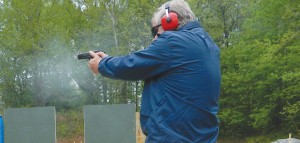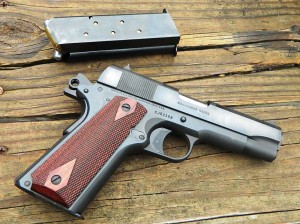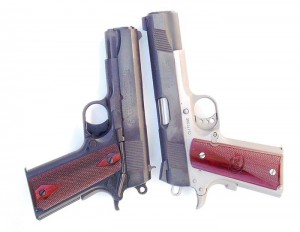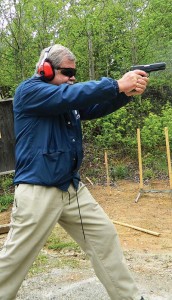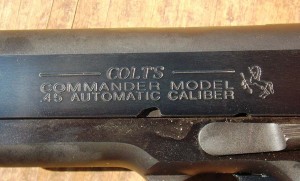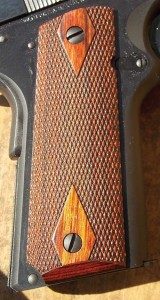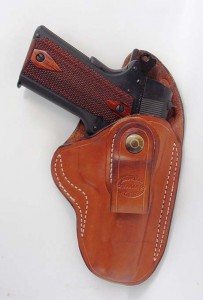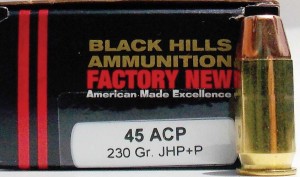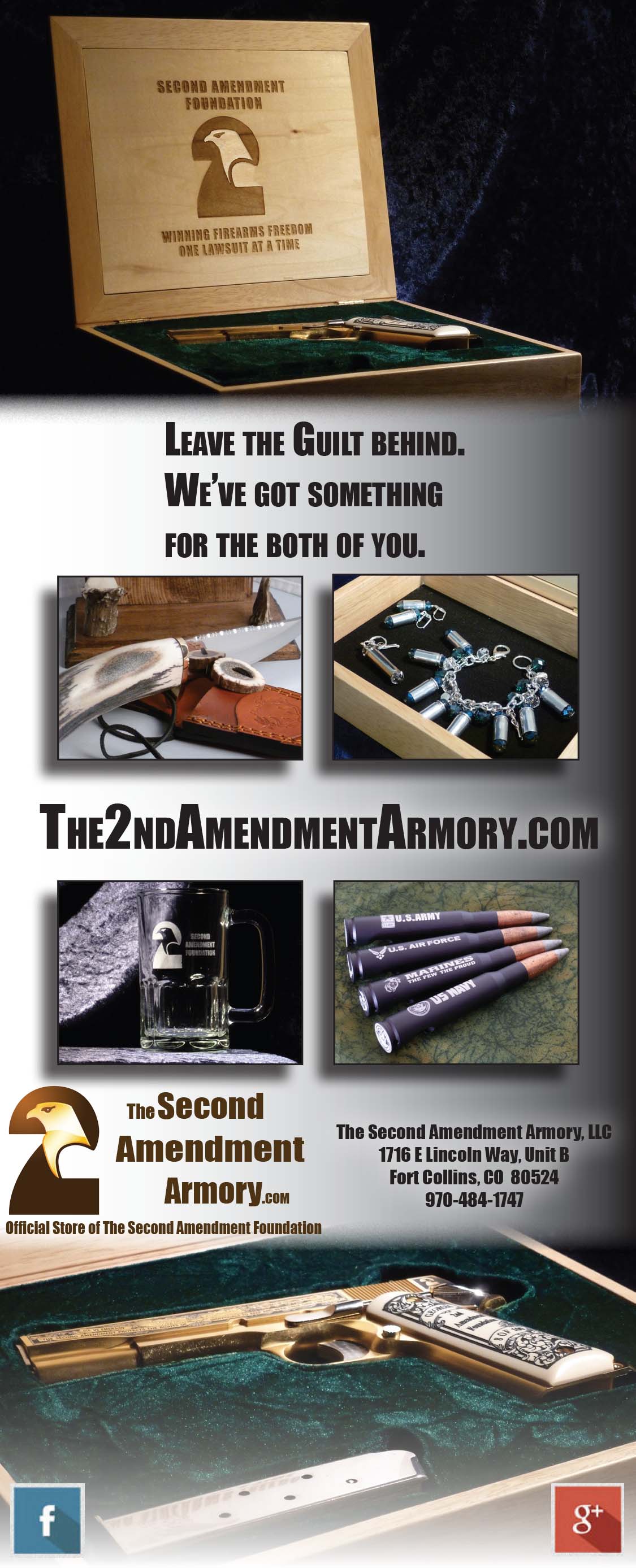By R.K. Campbell | Contributing Editor
The success of the Colt 1911 Government Model handgun was the result of more than a decade of painstaking development.
The .45 Automatic Colt Pistol cartridge was developed in a shorter period with input from many of the great minds of the day including General John T. Thompson. The Government Model served well. It became a favorite of military men such as T.E. Lawrence (of Arabia) and Sgt. Alvin York, and of lawmen such as Texas Rangers Frank Hamer and Long Wolf Gonzaullas.
However, those concealing the handgun under covering garments wished for a lighter handgun. In the days before World War Two, if the Government Model was too much to conceal, the next step down was to the Colt .38 ACP or even smaller, the 1903 Hammerless was a big one. Colt experimented with various compact 1911 handguns but World War Two’s advances in aircraft aluminum technology made the Commander Model feasible.
In America, Captain Hunt and George Clapp were working with aluminum as early as the 1890s. First worked successfully in Germany at the Duerener Metallwerke, this combination of duralumin was only 1.3 per cent aluminum with a mix of copper, magnesium and manganese. High strength and forgeability led to widespread use in aircraft. After World War Two aircraft aluminum technology made a durable pistol frame possible. Colt introduced the Commander Model with a lightweight frame and a slide and barrel shortened by ¾ inch.
The pistol kicked more than the 39-ounce Government Model but the new 28-ounce Commander took a burden off of the hip. In 1970 with the advent of the Series 70 pistols, Colt introduced the “Combat Commander.” This is the Commander with a steel frame. This pistol is even better balanced than the original and easier to use as well. Today all Commander-marked Colt 1911 handguns are steel frame guns. The aluminum frame Colt 1911s are marked “LW Commander.” The issue of longevity has been settled by firing trials with the aluminum frame. The real problem is ten-thumbed handling. Attempting to pry a safety lever from an aluminum frame, snapping the slide lock in place too forcefully and especially attempting to polish the feed ramp of an aluminum frame pistol may damage the frame. For most, the steel frame Commander is an ideal carry 1911.
I recently acquired a new model steel frame Commander. The first thing that I noticed about the pistol is that the blue finish is very nicely done, evenly applied and well polished. The grips are nicely checkered cocobolo. The pistol features several important improvements made in the Series 80 line. This includes high profile sights, a positive firing pin block or drop safety, and a well polished feed ramp design that insures the pistol will feed everything from lead semi-wadcutter bullets to exotic bullet styles. The ejection port is larger than the GI pistol. This allows sure ejection of a spent case and also the removal of loaded cartridge during administrative handling.
The barrel plug features a dimple to prevent the plug from taking flight during disassembly. The trigger action is smooth at five pounds even with minimal take up. A self-loading pistol must have some take up or creep and a noticeable reset for safety, but this is a good trigger action for personal defense. The trigger may be termed both tight and smooth. A straight to the rear trigger compression, a low bore centerline, and a grip that fits most hands well makes for a formidable defensive handgun. The low bore axis limits muzzle flip, there simply isn’t any leverage for the muzzle to rise.
There are more highly developed 1911 handguns including the Colt XSE Commander. The Commander illustrated has a classic look and all that is needed in a personal defense pistol and no more. The Commander suits me more than any other defensive handgun.
Cartridge of the Century
Despite revisionist history and fuzzy thinking the fact remains that the .45 ACP remains the single handgun cartridge that combines good wound effect with a self-loading action while also exhibiting low pressure. Until the laws of physics are repealed the .45 caliber cartridge will create a larger wound than a small bore handgun. Yet the .45 ACP cartridge does this with a low operating pressure of approximately 20,000 pounds per square inch or even less with most loadings.
The .45 ACP also exhibits excellent accuracy in a properly fitted handgun. The Commander’s sights are properly regulated for the six o’clock hold with 230-grain loads. For practice a 230-grain jacketed bullet is economical and accurate enough for all but match shooters. The Black Hills Ammunition’s 230-grain FMJ load has proven accurate and also demonstrates a full powder burn. A little known or acknowledged load from the same company is the 200-grain lead semi-wadcutter. Basically a factory version of a proven target loading, this is a load that often delivers excellent accuracy. The Colt’s one-in-16 inch barrel twist and conventional rifling are friendly to lead bullets. For personal defense the rule is a big hole going in and lots of blood out to maximize the shut-down of a closed system. People misunderstand shock, it isn’t the shock of being shot but medical shock is the loss of oxygen to the brain.
The .45 ACP delivered excellent wound ballistics. The Black Hills 230-grain JHP delivered a balance of expansion and penetration I am comfortable with. Some favor +P loads. I do not recommend a +P or any type in a LW Commander. However, for outdoor use or for those that often deal with felons in vehicles, the Black Hills Ammunition 230-grain JHP +P breaks over 900 fps from the Commander barrel.
This formidable loading isn’t that difficult to control in rapid pairs and maximizes the caliber. These choices fit my needs. As for accuracy, the pistol’s speed to an accurate first shot hit is what really concerns me. The Commander has this in spades. With any of these loads the Colt Commander will group five shots into 3 inches at 25 yards from a solid benchrest firing position.
The Commander is relatively flat, particularly when compared to a modern polymer frame pistol with a blocky slide. As such, a well-designed inside the waistband holster is ideal for concealed carry. The D.M. Bullard holster illustrated has given excellent service. This holster features double stitching, a secure belt loop that may be adjusted for cant and draw angle, and good molding. Speed is excellent. This Commander and D.M. Bullard combination are as ideal a concealed carry combination as may be had. It would be difficult to be better armed with a handgun. The Colt Commander is a classic, perhaps an icon. In a day when cultural icons seem self-promoted rather than recognized by professionals, the Colt Commander is the real thing.

